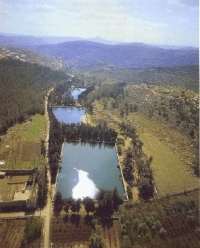Solomon pools |
| Dimensions according to Mazar 2002 |
| (in meters) |
L x W |
H |
Capacity (m3) |
| Upper Pool |
71 x 118 |
9,5 - 11,0 |
85.000 |
| Middle Pool |
135 x 50 |
10 - 12 |
90.000 |
| Lower Pool |
179 x (46 - 81) |
8 - 16 |
113.000 |
| Total |
|
|
228.000 m3 |
|
Capacity of the water sources |
| According to Mazar 2002 |
| (in m3)
| Annual
| Daily
|
| Wadi el-Biyar |
91.000 |
250 |
| 'Arrub |
227.000 |
625 |
| Local sources )* |
42.000 |
115 |
| Total |
|
990 m3/day |
Excluding leakages and evaporation during transport
)* Local sources: 'Ain Attan, 'Ain Saleh, 'Ain Burak, and 'Ain Farujeh
|
The total storage capacity in the Solomon's pools was 228.000 m3.
So it took over 200 days to fill the Solomon's Pools,
excluding the considerable (Mazar 2002) amount of run-off rain water
from the el-Hadr plateau near the pools.
|
|

